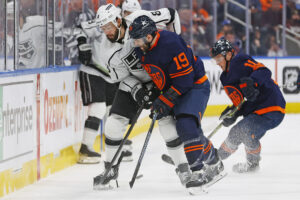Player development seems to always result in more questions than answers. How likely is it for a top pick to pan out? What makes a player a “steal”? Last Word On Hockey will be starting a new series on how to properly develop prospects from all different spots throughout the draft. This week’s piece involves top-15 picks and how they were used early in their careers.
Player Developments Of Top-15 Picks
In the span of 2005 through 2015, there were 21 total selections made between 11th overall and 15th overall on forwards playing in North America. Looking at all 21 forwards, they were split into different categories. Today, we’ll look at the category of “Rushed”. That category had six players, with four making their NHL marks in their DY+2 seasons. Those four players were Lawson Crouse, Dylan Larkin, Zemgus Girgensons and J.T. Miller. In this piece, we will be looking at Crouse and Larkin.
Player Development Of Lawson Crouse
Crouse, drafted 11th overall by the Florida Panthers in 2015, came from the Kingston Frontenacs organization in the OHL. In his DY-1, which was also his OHL rookie season, Crouse recorded 15 goals and 12 assists for 27 points in 63 games. That was good for 0.429 points per game, ranking 15th out of those 21 selections in DY-1 production. He followed that up with 29 goals and 22 assists for 51 points in 56 games in his DY, which was a rate of 0.911 points per game. That ranked 17th out of those same 21 forwards in DY production.
Crouse would stay one more season in the OHL and would be named the assistant captain of the Frontenacs. With the “A” on his jersey, he would score 23 goals and 39 assists for 62 points in 49 games, which was a pace of 1.265 points per game. That ranked 10th out of 20 forwards not yet playing at the NHL level in DY+1 production. Crouse would get his NHL chance, but not with the team that drafted him. He would play for the Arizona Coyotes.
How Was Crouse Used?
In his first NHL season, he would play 72 games, averaging 11:53 time on ice per game. Crouse would score just five goals and seven assists for 12 points in that role. Analytically, he was worse than the raw stats suggest. His even-strength offence goals above replacement (EVO) metric was an awful -2.5 while his even-strength defence goals above replacement (EVD) was also bad at -1.4. With his really poor even-strength metrics, his all-situations wins above replacement (WAR) was terrible (-1.4) and his all-situations goals above replacement (GAR) was even worse (-7.5).
With his awful rookie season performance, Crouse would play just 11 games the following year at the NHL level. Meanwhile, he played 56 AHL games, scoring 15 goals and 17 assists for 32 points. At the NHL level, he averaged just 10:56 time on ice per game, scoring one goal in that time. His analytics were better in an 11-game sample, but still bad. His EVO (-0.9) and EVD (-0.4) were still below replacement level. That led to his WAR (-0.2) and GAR (-1.2) to also be below replacement level.
New Season, New Crouse
Crouse would get a full NHL season in his third professional year and would establish himself as an NHL player full-time. He played 81 games, averaging 12:57 per game, a new high. In that bigger role and with more games played, he would score 11 goals and 14 assists for 25 points, all new career highs. Analytically, all of his stats were above replacement level. His EVO (1.0) and EVD (0.4) were improved, though still not great. Those improvements led his WAR (0.2) and GAR (1.1) to be much better than before.
Since that third season, Crouse has played three more years with the Coyotes and still remains with them to this day, though he is a free agent. Over the last three seasons, following his third pro season, Crouse has played 182 games, scoring 39 goals and 33 assists for 72 points. This past season was his best as an NHL player, recording 20 goals and 14 assists for 34 points in 65 games. His player development went as good as the Coyotes could have done, as Crouse simply needed to adjust and improve on his own. Simply put, the Coyotes gave him the role he best deserved based on performance.
Player Development Of Dylan Larkin
Larkin, drafted 15th overall by the Detroit Red Wings in 2014, came up from the USNTDP organization. Larkin would score 13 goals and 14 assists for 27 points in 55 games with the NTDP, which was a pace of 0.491 points per game. That ranked 14th among the 21 forwards in DY-1 production. He followed that season up with 31 goals and 25 assists for 56 points in 60 games with the NTDP. That rate was good for 0.933 points per game, ranking 16th out of those same 21 forwards in DY production.
Larkin would make the jump to the NCAA with the University of Michigan. There, he scored 15 goals and 32 assists for 47 points in just 35 games. That’s good for 1.343 points per game, ranking eighth among 20 forwards not yet playing in the NHL in DY+1 production. Larkin would make an NHL impact following this NCAA season with the Red Wings.
How Was Larkin Used?
Making the jump to the NHL level, Larkin would play 80 games, averaging 16:33 ice time per game. In that top-six role, Larkin would score 23 goals and 22 assists for 45 points. Analytically, Larkin’s EVO was outstanding at 12.4, while his EVD left a lot to be desired, down at -2.7. However, due to his strong offensive abilities at even-strength, his WAR (2.3) and GAR (12) were both really strong.
Dylan Larkin upped his scoring streak to 5 games (2-4–6). He’s earned a point in every NHL game he’s ever played in. pic.twitter.com/o69msam3Fm
— NHL (@NHL) October 18, 2015
In his second season, Larkin would play another 80 games, this time averaging 16:09 per game, and scored 17 goals and 15 assists for 32 points. His analytics painted an even worse picture of a down season based on raw stats. His EVO (-2.2) was terrible and his EVD (-2.6) was pretty much the same. Those poor stats led to his WAR (-0.5) and GAR (-2.4) to both be below replacement level.
Bounce-Back Season For Larkin Thanks To Better Player Development
In his third NHL season, Larkin would play the full 82 games, averaging 19:51 per game, a massive jump up from the past two seasons. In that large role, he would score 16 goals and 47 assists for 63 points, a big jump in production. Analytically, his EVO (11.4) would nearly return to his rookie season score, while his EVD (-6.9) got much, much worse. With the improvement offensively and the decline defensively, Larkin’s WAR (0.8) and GAR (4.0) were not great but stayed above replacement level.
After his third NHL season, he would play four more, all with Detroit. In those four seasons, he played 262 games, scoring 91 goals and 127 assists for 218 points. He still remains with the Red Wings to this day. As for his player development, things could have gone south fast after his poor second season. However, the Red Wings instilled faith in their young and talented prospect by giving him a bigger and better role suited more for him, allowing him to blossom a bit more.
Junior league stats via Elite Prospects, NHL stats via Hockey Reference, NHL analytics via Evolving Hockey






